#speculative culture
Text
Another Culture
While the Eastern coast and sea lives its own life, far inland another society is forming. The descendants of Middle East Steppe populations, with a varied array of tools they keep on their person at all times, have managed to explore deserts, savannas, steppes and temperate forests. Having started on shores of desert rivers, they learned to be both opportunistic and pacient, and, most importantly, crafty. While the Kaikainuchwer had a break from predators, having developed on islands, These people, the Kastakaama, have to be constantly on alert. While sometimes gender dictates a huge part of identity, in this society a huge part plays a shift one particular Sutviprra (Göts, in this language) choses to operate in.
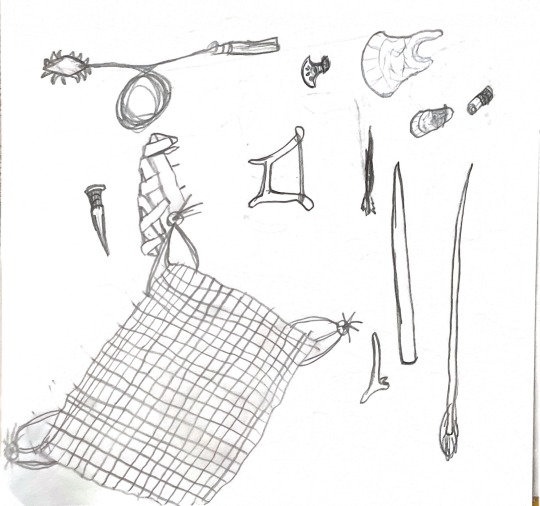
By themself, Sutviprra are not tied to time of day to function. Their ancestors could sleep for only four hours, but the newly grown brain demands much more “maintenance time”. So, to accommodate healthy sleep, while remaining constantly on guard, they adapted three shifts per day. The shifts are established in teens, when individuals decide on a graphic that is more comfortable for them. After that, in their adult life, they stay in their zone, while either staying on guard or performing their tasks. If their shift happens during dusk or dawn, a group of scouts set off to forage. As they return, food is prepared and saved, so currently sleeping members also get their share. During the day, the most dangerous factor is the environment - desert heat, sandstorms or floods. Most animals also avoid this time of day, but semi aquatic animals don’t have this constraint. Gafölatotsun is a giant ancient animal, convergently resembling crocodilians, though its four jaws give it more freedom of snapping. These animals rely on cover of water and ambush, but if they detect sleeping prey in the eyeshot, they would not miss their chance. Daytime centuries have to either scare off the predator, or wake everyone up. Though adult Göts is only quarter size of an adult Gafölatotsun, the river reptiles are very much aware of their disadvantage above the water surface. Worst case scenario is a genuine group of these beasts overwhelm the guardians. Mostly, the cause for wake up for all are natural disasters - flash floods from the rivers, coming from the mountains to the west, in cases of which Göts must retrieve to the highest point. Generally, those places are unstable sand dunes or rocky hills. Opposite of this situation is high temperatures. In those cases, Kastakama create communal dirt baths, though that usually puts them close to river shores, and therefore kastaGafölatotsun. Best natural solution to this issue are caves - any water-erosion caused pockets of shade, though there’s no telling if it’s already taken or not. So, in any crucial points of the families' yearly journey, one could find Gatozhanunu - a half underground building, constructed as a point to establish temporary camps inside and around it. Its subterranean nature and placements usually on the shallow shores, makes them vulnerable to floods. It frequently gets covered with sediment or even collapses. However, it is designed to withstand coverage. In fact, when the tribe leaves the Gatozhanunu, they cover entrances and windows with plastines of bone reinforced burnt clay, and as it gets buried, the house becomes sealed. When the family that built it returns, they excavate the building and unseal the building, with assurance that no unexpected dangers wait inside. Sometimes, the tribes perish, leaving the Gatozhanunu with no hosts. These rooms may be rediscovered during this age and adapted as new families safepoint, or, perhaps, these rooms may outlive this way of life, inspiring myths or providing knowledge for future generations.

#sutviprra#art#speculative biology#worldbuilding#spec bio#alien design#exobiology#spec evo#speculative evolution#speculative culture
8 notes
·
View notes
Text
Ea, Our Second Chance (16)
16. Ean heraldry
(Index)
(< 15. Dissection of trepangfish)

(original page)
« ... He doth bestride the narrow world like a Colossus, and we petty men walk under his huge legs, and peep about to find ourselves dishonorable graves. » – Cassius, in William Shakespeare, Julius Caesar, Act I, Scene II
« As the Romans knew well when they spoke of virtus, or the troubadours of valor, the worth of the sovereign is the same as his strength. Weak leaders terrorize their subjects, because they fear them; strong leaders want their people to walk with straight backs and eyes held high. Weak leaders keep their subjects quiet, because they have many mistakes to hide; strong leaders do not fear the truth. Weak leaders make their subjects work with the cane and the lash; strong leaders are served out of love. » – emperor Charles Saïd, A House Built on Sand
« There once was a fellow named Chuck / who was poor, ugly, and [redacted]-out-of-luck / He couldn't get laid / so he became king instead / just so he could find someone to [redacted] » – seditious rhyme of probable Pandavan origin, registered by the municipal police of Carcassonne, circa 310 AL
« One of Caesar Saïd's most ambitious accomplishments was the creation of a whole iconography from the ground up. Immediately after the Peacemaking Wars, he faced the need to strike a careful balance between the continuity of tradition with the culture of Earth, and the novelty of an empire of which he could be credited as true founder and maker... He would eventually resolve in favor of using organisms from this world, as popular choices from Earth's cultures such as eagles, lions, and bears meant little to the vast majority of his new subjects... Although it's interesting to notice that most of Saïd's heraldic beasts are in fact natives of Inanna, closer in location to the bureaucratic dreariness of Landing Point than to the fable spires of Montsalvat, but in the position of making the deepest impression upon the first generations of settlers.
... The springbear is an obvious symbol of overwhelming power. Like Hobbes' Leviathan, it can crush anything under its weight... As noted in Belvedere's recent work, it also represents an explicitely masculine incarnation of strength... Two charging springbears form visually the supporting columns of Saïd's personal coat-of-arms, strength channeled for the benefit of the Kingdom. The fact that no species of springbear is native to the Ninkasi Land does not lessen its significance anymore than the local lack of lions or, for that matter, unicorns lessened that of the British coat-of-arms on Earth.
... The colossal anzu-bird, which Saïd made a point of hunting personally in his harpoon-glider during his visit to Makka al-Jadida, justifies its own place in any heraldic system created on this planet... Named after the Mesopotamian harbinger of thunderstorms, the anzu combines extraordinary power and lightness, the qualities of an empire that must be at once immovable and dynamic; although at the same time its ungainly locomotion makes it extremely vulnerable on the ground... Its eye, in particular, caught the attention of poets and semiurges... ceaselessly staring at the blinding light of Utu, and nothing else, as the anzu fears no attack from above... The anzu-eye, as depicted for example on the chapels of Carcassonne and the ancestral shrines of Shangdu, is not merely a symbol of looking fearlessly into the sublime, but one that is purely an end in itself, with no need of practical justifications... In this sense it is contrasted with the anzu's olfactory flaps, distended in flight to detect food on the ground... In fact, the anzu is mainly a scavenger which, like Earth's vultures, uses its gliding capacity to cross the desert in search of carcasses, although it has been known to kill and eat living animals. The satyrical song "La Bravoure de l'Anzû", for broadcasting which Cyrus Yoshida was sentenced to sixty canestrikes in 266 AL, exaggerates its "cowardly" qualities, thus inverting its whole symbolic meaning...
... The honeybee was used by Napoleon and the early Mormons as symbol of industriousness and communal living (cf. the beehive structure of the townhall in New Zion)... In Ninkasi, its place is taken by the nest-building kirikits, who routinely risk their lives to gather food for their colony and defend it from predators. With their characteristic three hands and crude tool use, kirikits also add a connotation of intelligence that is lacking in bees... A colony of kirikits, almost two hundred members strong, is kept in the courtyard of the Imperial College in Mediolanum, making its nest on a grove of walnuts. The kirikit figures prominently on the College's paperwork...
... The use of the flute tree as symbol of pride and sturdiness is subtler, as it's not the whole plant, but rather the texture of its trunk that is used in heraldics... The peculiar "flute-bark" pattern (circles or ovals arranged in rosettes) is found on the ducal banners of Palmyra, the livery of land-based military officers, the porphyry paneling of the Ara Patrum... The apparent breaches or injuries in the trunk of flute trees are, of course, carefully crafted by nature to strengthen the trees, channeling the wind that would otherwise uproot them, and creating the lugubrious wail that resounds in the woods around Lake Svarog. This is exactly the trick employed by the architects of Palmyra for its high-rise towers, and by Sporean engineers for their arcologies, and serves as an excellent icon of resistance in the face of adversity.
... Saïd never quite justified his choice of the blue nova (Ouranthus cyaneus) as the Kingdom's official "flower"... It may have been a simple matter of personal preference. There are anecdotes about a young Saïd taking shelter in a grove of blue novae after being wounded in the Battle of the Sherida River... Richter has hypothesized a connection with the "Blaue Blume" of ancient German Romanticism, a symbol of longing and striving for the infinite, a fitting illustration of the motto Aut Caesar Aut Nihil... Less convincingly, Hrabe argues that the nine-fold symmetry of the plant-top might refer to the nine dukedoms of the Kingdom... »
– Theophilus Singh, Historical Compendium of the Celestial Kingdom, volume I, chapter IX, 276 AL
« I had a scaffold built just outside of Water's Edge [Byzantium], near where the river Sherida meets the waves of Rahab. The beauties of Ninkasi Land had fueled only corruption and debauchery for far too long an age [...] Three hundred prisoners, the worst criminals I could find in the long years of war, were brought there on open cars. Pirates, druglords, highwaymen, mobsters, terrorists, skilled in the crafts of murder, robbery, rape, and torture; those whose crimes were beyond pardon, those who could not be allowed to live in My Kingdom nor loosed upon other nations.
I had a theatre prepared around the scaffold. Nothing more than a few hundred folding chairs and fundamental facilities for the businessmen, the townheads, the landlords, and the scholars of Ninkasi. [...] Twenty by twenty the criminals went to the scaffold. My own black-gloved hand triggered the mechanism; they fell through the floor; the rope wrung their necks; and they died. Many of My men, who had suffered all manners of cruelties and indignities by their hand, regretted only that they would go so quickly to their final and greater Judge.
Other twenty came after, and then twenty more, until their whole number of three hundred was consumed. Some found some dignity in their final hour; some, who had never wept for another, wept for themselves; and some fell cursing God and Man, perjurying their innocence, and offering other, better lives in their stead. [...] Their bodies were buried on the shore under a great black stone, where good people still fear to tread. [...]
When the clocktower of Water's Edge struck one, I bade the witnesses rise. They would swear an oath of fealty to Me, and serve as My ministers and vassals, or simply My subjects; or they would leave the borders of the Kingdom forever, and forfeit any property they could not carry out within 48 hours. [...] A Joseon-born businessman, who had enjoyed much profit from the sale of unwilling services, said that I could not consider free an oath taken on pain of losing all of one's life's work. «Vae victis,» I responded; «It is only by My mercy that you are given this choice».
Four fifths of the present took the oath. The Europeans genuflected, the Americans saluted, the Chinese kowtowed, the Japanese bowed. All these gestures have the same meaning, and I accepted them equally. The rest was escorted to their homes to prepare their departure to our new borders. [...] My men, the children of Ninkasi, raised their guns, and thrice they cried as one: «Vive l'Empereur! Vive César Saïd!» A salvo of artillery made the distant hills tremble. The drone fleet traced My coat-of-arms in the skies.
Nine months later, the ground where Cutter's Bend once stood had been cleared of all contamination; and upon the basement of its ruins Montsalvat now glittered with marble and silver. There I kissed the hand of His Holiness Neophytus III; and there, after twenty-seven years of blood, sweat, and tears, the Titanium Crown finally rested on My brow. »
– Emperor Charles Saïd, quoted in Theophilus Singh, Historical Compendium of the Celestial Kingdom, volume III, chapter XIV, 279 AL
#speculative biology#speculative culture#scifi#worldbuilding#alien world#future history#my work#ea our second chance
8 notes
·
View notes
Text
Welcome to the Science Pit
Tags I use:
----
Scale of Realism:
#reality -self explanatory, this is usually research-related and describes a real phenomenon.
#shitpost -Science related shitpost. May overlap with reality, may not.
#fiction -Fictional science stuff, has sub-categories.
#PSA -This post contains information which is important and should be spread for safety or other reasons.
----
Under Fiction:
#scifi -science fiction. Aliens and stuff.
#fantasy -unicorn and dragon-type science.
#speculative science/culture/biology/fiction - fiction that speculates on scientific topics.
#mad science - fiction centering on mad science.
----
Specific Sciences (all self-explanatory):
#biology
#zoology
#botany
#chemistry
#organic chemistry
(Note: there are other more specific tags, but these are the umbrella tags.)
----
Miscellaneous Zoology/Animal Specific:
#human intervention (positive) -positive interaction between humans and animals- often domestic animals or professional rehabilitators
#human intervention (negative) - Negative interactions between humans and animals- think humans with exotic pets or feeding wildlife or mistreating domestic animals.
#dangerous interactions -interactions between species that are unsafe for one or both parties, like cats and birds or other predator/prey interactions in domestic situations.
#cute animal - Critters considered conventionally cute- cats, dogs, raccoons, etcetera. This tag will be excluded from dangerous or negative interaction posts for obvious reasons.
#unconventional cute animal - Critters I consider cute, doing cute things. May include arthropods.
#predator prey - interactions in the predator-prey dynamic. Involves suffering or death by one party to sustain the other.
----
My Additions (stuff I add to the conversation):
#Kenopsia commentary - my commentary, not necessarily adding new information.
#Kenopsia explains - me trying to explain a phenomenon.
#home science advice - my advice on little bits of science you can do at home safely (birdwatching, for example)
----
Miscellaneous tags:
#death - post contains explicit talk of death.
#bugs - post contains arthropods that some may find upsetting. This is not a scientific tag.
This post is tagged with all of the tags listed above for ease of navigation.
#speculative science#biology#reality#shitpost#speculative culture#speculative biology#speculative fiction#chemistry#zoology#botany#fiction#scifi#fantasy#mad science#organic chemistry#home science advice#cute animal#PSA#human intervention (positive)#human intervention (negative)#dangerous interaction#predator prey#death#bugs#unconventional cute animal#Kenopsia commentary#Kenopsia explains
2 notes
·
View notes
Text
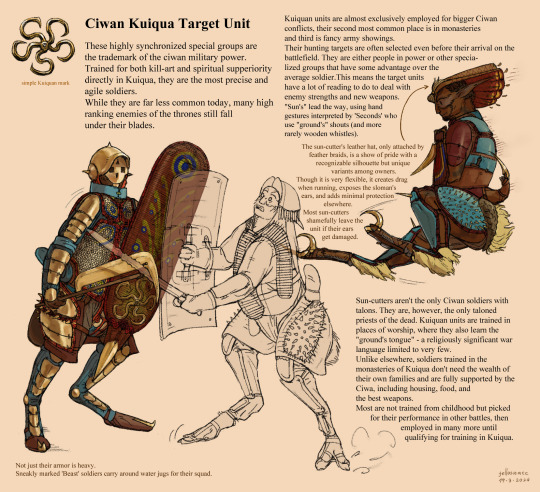

Welcome to a long one.
The Ciwan empire is the fastest-growing sloman power ever since the war of continents and the first to discover a form of gunpowder (thanks to their enemies being uniima lls who have been using it long before).
But even with that advantage (among slomen), the Ciwan armies are iconic for a different reason. That being the Kuiqua-trained units that Sun-cutters come from.
These units have traditionally existed for hundreds of years but are slowly just becoming a symbol for show because of the political and battling changes in the world. However, you will still see them from time to time ripping people to pieces.
Just like the majority of sloman military groups the unit relies on intense teamwork, they need constant communication and preplanned routes to deal with the opposing strategy.
The simplified average scene might look something like this:
In one unit of 30 members, three strikers (Sun-cutters) make a plan with their scholars and commanding Fire-catchers (Seconds leaders). After getting to the war zone they wait for their window in which some members spy or communicate with deeper army spies. When they know their target and best strategy they get in. The strikers use hand gestures, clicks, or whistles to save energy while the Seconds forward the orders to the rest with "ground's" (war language), wooden whistles see more use in very large units. Many times, however, often just seeing the movement of the sun-cutters is enough for the whole group to act.
Strikers will sometimes wait behind their heavies (Beasts) if their force isn't necessary (units can be as few as 5 members or as many as 50, the two extremes work very differently). Once the situation calls for it, they bullet their targets, often stabbing talons first and tearing muscles in a swift motion. This may happen multiple times as other unit members engage in direct battle with the target/s or disarm them with specialized tools. Kuiqua units both kill and capture, having healing supplies on their heavies if they need to make sure their target doesn't bleed out (or their own soldiers).
All members of the Kuiquan unit are priests of different levels but all are priests of the dead (ones that speak for their ancestors rather than gods). It's believed lands conquered with these soldiers present will flourish with life. Many former battlegrounds have turned into gardens and crop fields (hopefully they don't keep this up when landmines are invented).
To the image. What you see is a small variety of soldiers. Beasts and fire-catchers have other names and features in their armor that they are known for based on all their roles that can often switch between fights. Only Sun-cutters truly have one name.
Fire-catchers are also sometimes strikers in training and may move up if they prove themselves. Though, more often Sun-cutters rise from the ranks of regular taloned soldiers with enough talent.
-
As mentioned in the image, Sun-cutters tend to be very prideful. Their helmets are an impractical mess that pushes their ears forward. A Ciwan Sloman's ears are very important to them and if they are damaged it's a career-ending event. Still, almost no strikers bind their ears, not wanting to be shamed for cowardness.
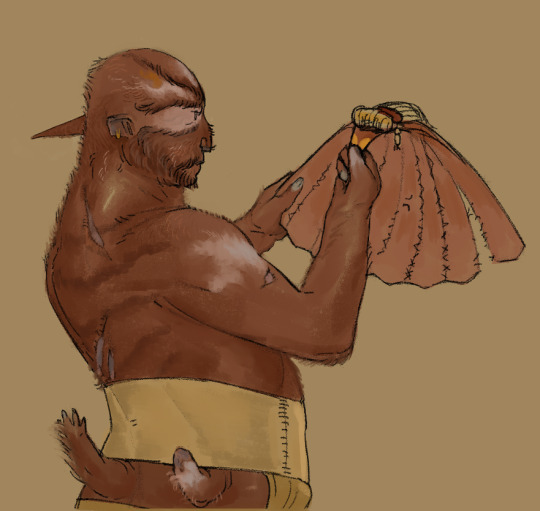
an ex-striker
here is the whole picture if you prefer it big

Btw, Kuiqua is the city Neal lives in. He has met or been arranged to meet these units multiple times since Neal himself is stuck classified as a fancy soldier. They are also not uncommon around temples, small talk is required.
Thank you for reading this far! Next I must answer the questions of biology. This has taken me 50 000 years.
#art#speculative biology#artists on tumblr#digital art#artwork#worldbuilding#speculative evolution#spec bio#sloman culture#slomen#fantasy culture#alien culture#character design#illustration#sloman military
482 notes
·
View notes
Text

Towers are a neolithic sophont race with two strains.
#my art#towers#Hrng I have so much info on towers you don’t know#speculative biology#Chances are if you send an ask about their physiology/psychology/culture/technology I will have a response.#Nearly every ask I’ve received I have a response to.
628 notes
·
View notes
Text

Gwlanad and Uminno fayons trading goods.
#illustration#worldbuilding#original species#speculative biology#spec bio#art#fantasy#sokiin#fayons#fantasy culture
114 notes
·
View notes
Text
What are Kazuki and Rei’s Options? - Buddy Daddies - Episode 10 - SPOILERS!
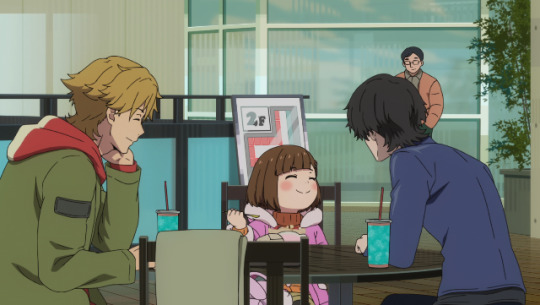
In Japan, same-sex couples cannot adopt children:

Text: Adoption and parenting Same-sex couples are not allowed to legally adopt in Japan. Lesbian couples and single women are unable to access IVF and artificial insemination.
(From the Wikipedia page on LGBT rights in Japan, which will be linked in the comments.)
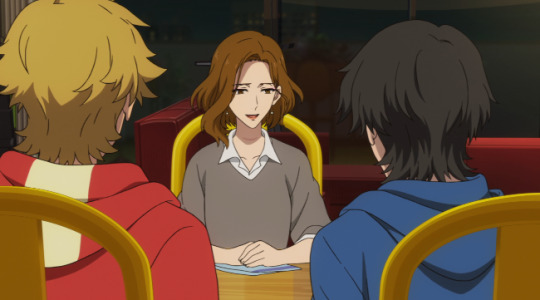
However, fostering children is currently an option for same-sex couples:
Now, in another sign of increasing acceptance of the LGBT+ community, it’s come to light that the city of Osaka has awarded foster care of a child to a same-sex male couple. While city administrators confirmed the couple’s foster parent status on April 5, 2017, the pair, consisting of one man in his 30s and another in his 40s, were approved as foster parents back in December of last year.
Foster parent certification falls under the jurisdiction of local authorities, but Japan’s central Ministry of Health, Labor, and Welfare says that it has no previous record of a same-sex couple being awarded foster parent status, so the decision by Osaka appears to be the first of its kind in Japan. The Ministry also confirmed that its guidelines regarding foster parent selection make no specifications barring or giving preferential treatment to same-sex couples.
(Source: All About Japan - “Same-Sex Couples Can Now Be Foster Parents,” full article will be linked below in the comments.)
This is basically what we see Kazuki and Rei do, as of right now, with Miri. They foster her for a year, and she has returned back to her birth mother.

Now, what will happen next is unknown. There are options like Miri never returning to them/staying with her mom, one or both of them dying, etc. etc., but we aren’t going to be looking at those possibilities right now. Let’s look at ones where Miri is a part of their lives.
If they want Miri back in their lives then Kazuki and Rei will have to take care of the Organization and their connection to it, and then find alternative jobs to support themselves. Buddy Daddies takes place in modern day Japan, that is the setting, and they are treating the situations as functioning within the framework of what can and cannot be done in modern day Japan, in regards to childrearing, childcare, and so forth.
Unless they go the route of having Kazuki forge paperwork to be her birth father, since they look very similar:
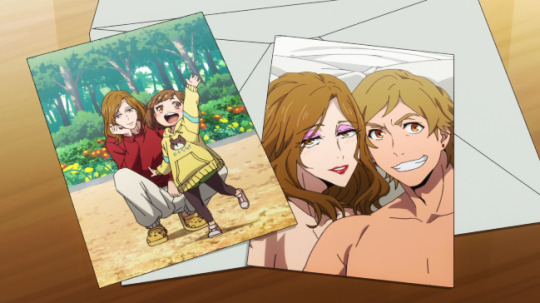

Of course, this option would be a bit more convoluted. He couldn’t take on Miri’s birth father’s actual identity because he was a mafia boss and is currently, very much so, dead. But, they might be able to change it so that Miri would be Kazuki’s daughter. Then, Kazuki and Rei would be able to raise her, since she would be Kazuki’s birth child.
But, unless Misaki were to pass away due to her cancer (which is a possibility, especially since she mentioned that it was spreading), the end result would still be a blended family situation:

Because even if Misaki had given Miri up for adoption or had abandoned her, the birth mother is still the legal guardian of their child. Unless the birth mother dies or goes completely MIA or the child isn’t put into the system at all (essentially just living on the streets), then there isn’t a way, in current Japanese society, for a birth mother to be completely divorced from their child.
That being said, blended families do exist in Japan, especially in the modern day when divorce, remarrying, and same-sex relationships being recognized are all becoming more common place. But, we rarely see blended families being portrayed in anime (specifically, I’m sure there is some exploration of this found in manga), and certainly not at a central level of any kind (like with what we have been seeing with Buddy Daddies and how it has been centralizing its focus on childcare and childrearing).

An blended family ending would still be just as queer and progressive as before. This sort of family dynamic would exist outside of the norm, and outside of the nuclear family expectation. The framing has been interesting too, because Miri’s mother is the one that essentially has to prove herself to both Kazuki and Rei and to Miri. She was brought back into the picture because it was the safer option for Miri at this moment, not just because she is Miri’s birth mother.
So I feel like, if a blended family situation does end up happening in the end, they won’t approach it in quite that way. Though, I also think that would be a point of contention at times (especially between Misaki and Kazuki) that wouldn’t be that uncommon for a blended family situation. Navigating issues like that is very common, I see my friends who are step-mothers and step-fathers have to navigate those waters often. If it were depicted in anime, even if it were for a brief bit (or in more depth if there were a second season and this is the route the series ultimately goes down), then that would be pretty neat.

Something else to note is that when Misaki states: “If you consider yourselves her parents as well,” she uses the word “parents,” 親 (oya), not guardians, 保護者 (hogosha) or other similar/related words. 保護者 (hogosha) does mean parent, but in a more inclusive way that is also referencing legal guardians as well. But she is acknowledging them as parents, the same as her.
Of course, there are some who are weary and skeptical of the integrity of Misaki. I think she is talking honestly and sincerely here, along with the rest of the episode, but if she’s not, then what will happen to Miri is that she will likely go to live with her grandparents or, like I mentioned before, the series goes a bit more of a convoluted and complex route with making Kazuki’s Miri’s “birth” father through forgery and the like. Or, they break the more realistic boundaries they’ve been working within so far, and make it so that Kazuki and Rei can just magically adopt Miri, but given the “realistic” mentions in a lot of the interviews with Uchiyama and Toyonaga, I don’t think that is likely.

If the series does go the route of having Miri go to live with her grandparents or mother and Kazuki and Rei aren’t brought into the family in a blended family way, but more so kept out (maybe with only the occasional visit or something). Then another possibility, especially if they do end up leaving the Oraganization and kind of “starting over” with new jobs and the like, is them becoming foster parents in general.

Miri would be the first and the most precious one to them, but then they find a “normal happiness” with each other and become foster parents to other kids in the future. It would be a nice way to really show them changing right, in the sense of, instead of taking human lives, they would be caring for and fostering children - the future, and hopefully helping them turn out to be good people. That’s always a possibility, especially if there is some kind of large time skip in the last episode.
Of course, the series could instead go in the direction of criticizing the cruelty that same-sex couples cannot adopt and therefore are basically only left with the option of fostering, unless they have a blood-related child through natural means of birth. That is always a possibility as well, and is something that I feel they do kind of hit on a bit in Episode 10, especially with Rei’s line here:
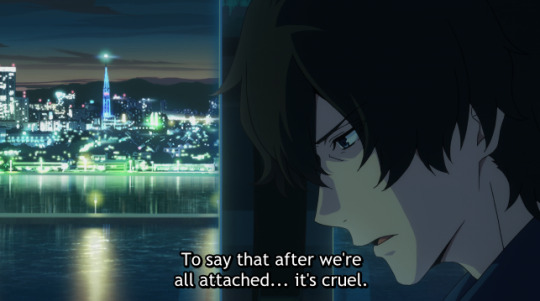
(Rei: “To say that after we’re all attached...it’s cruel.”)
But yeah, thinking about it, when it comes to positive outcomes, in the sense of Kazuki, Rei, and Miri living and Kazuki and Rei being able to escape the Organization, then I think the ending options are going to be one of the above. Everything in this post is pure speculation, since the series is anime original, we don’t know for sure what direction it will ultimately go in.
But these options here are the ones sticking out the most to me at the moment (once again, if we only look at potentially happy endings, rather than any potential overly tragic/bad end ones). It’s also possible that they may be critical of something (like with Rei’s words on the cruelty of it all), while also still painting an option, like Kazuki and Rei deciding to become foster parents, as something that is still an overall good and positive change for them, specifically.
I like there is a potential messiness to the situation and overall premise that is presented in Buddy Daddies, because it makes it feel like the series is properly exploring the realities of the situation and the options that are open and available to Kazuki and Rei. It’s bleak in some ways, hopeful in others, and I am intrigued by what direction they will ultimately go in.
As always, feel free to add your thoughts to this as well! :D I always love reading them! <3
#Buddy Daddies#BD#KazuRei#Kazuki Kurusu#Rei Suwa#Misaki Unasaka#Miri Unasaka#blended families#Japanese culture and society#LGBT in Japan#LGBT issues in Japan#adoption in Japan#fostering in Japan#long post#image heavy post#analysis#speculation#meta post
782 notes
·
View notes
Note
Do kyhuine have a clothing item that is as significant as the maanuls hats?
context: eastern maanul hats are mentioned here
Yes, kyhuines have ridiculous headpieces that can rival if not "win" against eastern maanul hats, while id like to dedicate posts for each region I can still show the biggest one, which I will probably make a whole post about them soon since the art is done.
a headpiece from the salt rock kyhuines/salt desert region, usually worn by males during some very special ceremonies. they're not an everyday hats to wear.

The eastern maanul's hat holding so much significance socially is quite exclusive to them among's maanuls, while hats are a universal piece of clothing to make none of them can rival eastern hats being so heavy and over the top with jewels. While other maanuls like the west who have hats inspired by the east are toned down+ hat makers like the ones in the eats who can work with shells are quite rare outside of east regions.
other regions of kyhuines also got special headware too, but they're not as big as the salt desert people's. like maanuls some will be for religious purposes, others more of a fashion thing to wear, and so on
bonuses

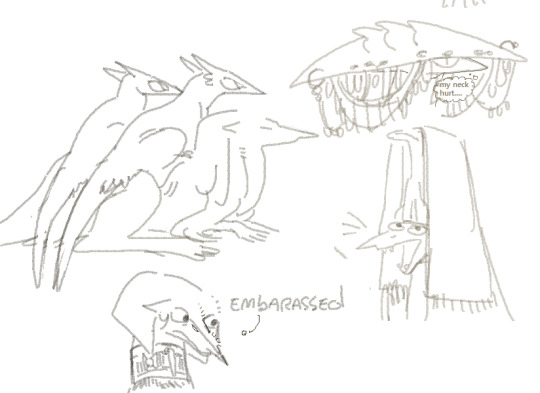
#textile#kyhuine#culture#salt desert#altuyur#ask#digital art#my art#oc#artists on tumblr#worldbuilding#speculative zoology#kaasim#clothing#partly ms paint#partly FA#xenobiology#2023
353 notes
·
View notes
Text

"Do you feel safe now?"
i feel the burnout gnawing at my ankles so i'm trying something different to scare it off
#creature#alien species#creature design#xenobiology#spec bio#spec evo#original art#speculative evolution#speculative biology#the chirpers#abstract pattern#the critter on the left is a predator the Chirpers hunted to extinction in the wake of a extermination campaign#they did this to most of their predators#they didn't take into consideration the harm they caused to various ecosystems#a lot of their culture in the industrial age is about overcoming and dominating so these culling were a bit of a coming of age thing as well
122 notes
·
View notes
Text

Slug people harvesting fruit on an aquatic tree farm
#art#drawing#pencil on paper#slug#alien#alien species#speculative biology#spec bio#alien culture#the grabby claw thing would probably just crush the fruit but oh well#easy way of making jelly i guess#my art
120 notes
·
View notes
Text
I want to make a longer post about this someday but: I think Arya's TWOW arc is going to include her coming to terms with her identity as a Lady. This has been an ongoing conflict with her since her first chapter and I think her flowering in winds is going to mark a turning point. The theory of her having an apprenticeship with the courtesans holds a lot of weight and the idea of Arya going through puberty among a group of unconventional women she's fostered a positive relationship with is just too perfect. It would really have an impact on Arya reconciling her personal idea of what a Lady should be. There's also a lot that she could learn from them in terms of courtesies, communication, appearances, body-language, etc. that would elevate her current skill-set and ways her relationship with them could push the plot.
Not to mention she will undoubtedly reclaim her identity as Arya Stark, and her being a Lady is inseparable from that. Arya Stark is a Lady Stark and being a Lady is a social position, not a measure of how well someone preforms feminine tasks. She shouldn't have to relinquish her position because she doesn't fit patriarchal standards. That's not to say that she's ever going to be the perfect example of a traditional Lady but what I think will happen is that she becomes capable of playing the part. She plays several identities throughout the series but she's always been Arya underneath, so I think it's appropriate that she learns to adopt a "persona" that's part of her. Her remembering Ned putting on his "Lord's face" (+ the various examples of other characters being separate from their ruling persona) makes me think that Arya will be donning her "Lady's face" when she makes a return to Westeros.
#arya stark#asoiaf#twow speculations#Arya has been through so much traumatic shit and I think her flowering is going to bring up a lot of her self-esteem issues#I just really need her surrounded by kind older women when that happens so she can have some comfort#George saying her arc in braavos could be the plot of a YA novel?? definitely makes me think she's going to grow up a lot there#she's already one of the most mature characters so I think part of it's going to be her accepting her duty as a Stark Lady#she wants to help and protect people and the best way she can do that is if she has political power#She could learn that first hand in TWOW#possibly through her finding out about her marriage??? and meeting Jeyne in Braavos??#and before someone says it courtesans are so much more then sex work so I don't want to hear it#they are such a big part of Braavosi high life...they're cultured and connected with very important people#I just have so many thoughts on the subject cause I think her apprenticeship with them will serve multiple purposes#the faceless men and their plans...the iron bank...the sealord...It's all connected and I think her apprenticeship with them will kick off#the braavos plot and could mark the beginning of the end of her time with the faceless men and in braavosi#half a boy half a wolf pup -> half a lady half a wolf#I think her current skillset fits well and it's likely she'll learn even more in TWOW#Arya defining her own role as a Lady and becoming comfortable means so much to me
221 notes
·
View notes
Text
My fucking confession to that fucking blog I won't waste my time submitting bc really what's even the point of talking to someone who doesn't want to open their minds and understand is that y'all came out of reading and experiencing svsss not having learnt anything.
When written within the bounds of the original genre, this kind of character was extremely difficult to handle. You could say he was scum, but he was also pitiful. But if you tried to acknowledge his pathos, his ruthlessness was real too. Characters that were both scummy and tragic always drew aggro, and they were a hotbed for wank, leading comments sections to devolve into massive flame wars. Better to hack him down into a formulaic asshole and let the protagonist step on him. Easier to write, and the readers would find it satisfying as well. (Chapter 19: Shen Jiu)
this is why writers can't write complex villains, bc you all with your moral purity takes can't handle it. bravo, you've proved mxtx right.
some of you get soooooo twisted trying to defend SJ you flatten his character and make him into a parody of himself.
some of you are so wrapped in the pity contest of "who suffered the most" to determine who has the moral highground that you don't get that you can't pit a character's pain against another character's pain. abuse is abuse is abuse. QJL was abusive for three years, SJ killed him. SJ was abusive for aprox. 5-7 years, Bingge tortured him AND killed him. And killed everyone associated to him. Somewhere down the line, I bet that in real PIDW verse someone will try to take out Bingge for all the suffering he caused. the point is that they BOTH did SHITTY THINGS, they were BOTH abusive because they DIDN'T RECEIVE ANY LOVE IN THEIR LIVES after they were abandoned. both shen jiu and bingge are scummy and tragic. BOTH OF THEM. and because of the abuse and trauma they suffered, they both had awful coping mechanisms that entailed taking out their pain on people who didn't deserve it.
and that's the whole fucking point!!! they're deliciously complex characters. they were born from the fucked-up union between the cycle of abuse and toxic masculinity. they are simultaneously constructions and deconstructions of the Villain Character. they are profoundly human as well, because they showcase the darkness of the human experience, what happens when a person transforms their pain into a weapon to hurt others.
and y'all are arguing over who is innocent? get out.
#svsss#svsss meta#zykamiliah-svsss#shen jiu#luo bingge#bingge#luo binghe#and don't get me started on the whole virgin thing#as if sj being a virgin or not is ever made clear#we don't fucking know that's the issue#we can only speculate#(take a shot every time mxtx leaves something unexplained-- you'll be drunk in half an hour)#regardless treating sj being a virgin as a get out of jail card is hilariously stupid#get your purity culture takes out of the svsss tag please they contribute nothing to the discussion
155 notes
·
View notes
Text
Ea, Our Second Chance (2d)
2d. Ea: the human presence
(> Back to 2c. Life on the planet
> On to 3. South of Dagon)
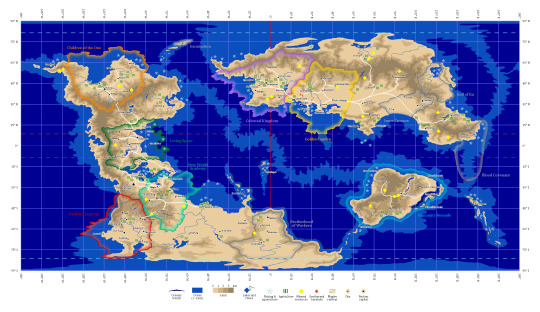
(full image)
« We were born into a broken world. If our existence has a purpose, it is to fix it. » – "Gene Taylor", Hypertopian Manifesto, incipit
« ... The closer you come to true freedom of association, the closer you get to a world where everyone is a member of more or less the community they deserve. That would be a pretty unprecedented bit of progress. » – Scott Alexander, Archipelago and Atomic Communitarianism, 2014
Humanity came to Ea a little over three centuries ago. The Ark left Earth sometime around 2070 CE, carrying ten thousand cryopreserved people that roughly reflected the variety of the human species, vast electronic archives detailing millennia of history and culture, compact industrial machinery, frozen seeds and embryos of hundreds of plant and animal species, and most importantly tools to measure planetary habitability (gravity, surface temperature, atmospheric composition, distance from star) from light years afar, and a limited AI to judge what world held the best chances for humanity.
The mission didn't quite work how it was meant to. Nobody knows exactly how far the Ark traveled, or or how long; and, as far as they can tell, no message was ever sent to or from Earth. Nevertheless, the passengers survived. The Ark placed itself in Ea's low orbit, and thawed its human cargo. 100 landing pods reached the surface a few hundred km south of the Dagon Sea, while the bulk of the starship was left orbiting the planet.
Ea is cold and dry, its winter incredibly long and harsh, its summer brief but sweltering; the atmosphere is choked with toxic amounts of carbon dioxide, from which both biospheres nevertheless depend for survival; there are no convenient deposits of fossil fuels; and native life is unfamiliar and often dangerous. The first generation of colonists suffered terribly, but eventually they learned both to adapt themselves to Ea, and to adapt Ea to them.
When population started to grow and material prosperity to rise, disagreements arose on how to organize their young society. Many resorted to violence to extract resources from their neighbors or to impose their ideals on them; warlords and tyrants arose as the authority of the Mission Commanders declined. Disruption to Ea's biosphere spiraled out of control, as plants from Earth throve uncontrolled in the abundance of carbon, and humans drilled boreholes through the crust or blasted apart the icecaps in the attempt to prevent temperatures from falling.
Still, in the end, a stable order took shape. People scattered on all the planet setting up whatever form of society they preferred, as free as possible from each other's interference, each trying to relate itself to Ea in a different way. The greatest powers (in the colored borders) are united in the Sevenfold Pact, in which they pledge to respect all others' independence, and to allow every citizen to move to the society of their choice unimpeded. Smaller nations (in grey in the map) have arisen elsewhere, enjoying the same autonomy, though they are not members of the Pact. In the spaces inbetween, dozens of smaller communities host people united by common culture, religion, or ethnicity.
(List of named polities under the cut)
SEAT OF THE METAGOVERNMENT: the central seat of the Sevenfold Pact.
Landing Point (this is, of course, the point where the landing pods first reached Ea's surface).
THE SEVEN SIGNATORIES: the powers that ended the Planetary War by creating the Pact.
Children of the One: Olduvai*, Amma, Imani, Laetoli, Maisha, Mizizi, Selam, Toumai, Upendo, Uzuri
Living Spore: Galapagos*, Cascadia, Coenobium, Guanacaste, Jannah, Karisoke, Pachamama, Vernadsky, Virunga, Volvox
New World Academy: High Court*, Chagas, Galileo, Lavoisier, Leeuwenhoek, Ockham, Pavlov, Ramanujan, Tsiolkovsky, Wegener
Pandava Legions: Fort Vajra*, Arrowhead, Camp Glacier, Camp Thunder, Deepford, Freehold, High Clearing, Redfield, Thornwood, Whitestone
Humanity Remade: Prime Node*, Breath of Dawn, Embrace of Kindness, Glow of Aurora, Hope of Humanity, Nest of Warmth, Peace of Mind, Scent of Water, Song of Bliss, Voice of Flower
Golden Garden: Penglai*, AtlasCorp, Helios Energy, InterChem, Luxor, Kuznetsov, NeuralArts, Qian&Gupta, StarSeeker, WeltraumStahl
Celestial Kingdom: Montsalvat*, Axum, Babylon, Byzantium, Carcassonne, Djenne, Mediolanum, Palmyra, Shambhala, Shangdu
LESSER POWERS: other important polities with less global influence.
Brotherhood of Workers: Phalansterium*, Beccaria, Kulischov, Kropotkin
Blood Covenant: (none)
Soil of Ea: (none)
Inner Cosmos: Tharmas*, Los, Luva, Urizen
Incarnation: Self*
EXCLAVES: autonomous city-states founded on different principles.
Ethno-cultural: Babatunde [Yoruba], Beaufjord [Scandinavian and Canadian], Civitanova [Mediterranean], Gandhara [Indian], Gokturk [Turkic], Joseon [Korean], Hanunah [Pan-American], Sama Orang [Malay], Shin'yamato [Japanese], Svoboda [Slavic], Tianhua [Chinese], Vrijburg [Germanic]
Religious: Beit haShlishi [Orthodox Jewish], Bodhisvaha [Buddhist], Devanagara [Hindu], Faluncheng [Falun Gong], Makka al-Jadida [Sunni], New Zion [Mormon]
Experimental: Aryavarta [Proto-Indo-European reconstructionism], Kallipolis [Plato's Republic], Panopticon [self-explanatory], Port Royal [egoist anarchism], Shulamith [female separatism]
* = national capital
#speculative biology#exobiology#future history#alien planet#speculative culture#my work#ea our second chance
5 notes
·
View notes
Text
People in the late 20th century thought the fundamental arc of human history was exploration, whereas now it looks like it's information processing.
In traditional science fiction, the historically progressive human urge is wanderlust, the pull of unknown geography, horror vacui or amor vacui depending on how you look at it. Those writers invoke the elapse of time that separated Kitty Hawk from the moon landing. They recite a procession of discoverers that includes Columbus or the Polynesians and whose next logical steps are space colonization and superluminal travel. Era-defining technologies are transportation technologies. You still get this now, sometimes. In a much-dunked-upon scene in Star Trek: Discovery (2017), a character's litany of great inventors includes the Wright brothers, the guy who invented FTL, and Elon Musk.
The corresponding fear, of course, is alien invasion—that we are not Columbus but the Indians.
Now, the developments actually restructuring people's lives are either of the computer or on the computer. The PC, the internet, smartphones, social media, LLMs. Bits, not atoms. It has been this way for some time, though it hasn't fully made its way into culture. The progenitors of the new future are writing, the printing press, the abacus. We can see the arc clearly in retrospect, now that the future seems likely to be defined by machine learning.
Just as before, there is some anxiety that our trajectory will lead us into the grip of alien intelligences, horrendous and devouring.
If you go back to the period stretching (roughly) from the late 19th century through the Second World War, stories often hinge on wonder-substances and novel fundamental forces. This was, of course, an era in which a new force or element was turning up every other week. You couldn't swing a cat without hitting one. They discovered guncotton when some guy left his fouled lab coat next to an oven. Hence, Vril, the Ray, the "eighth and ninth solar rays" of Burroughs's Mars. In later stories, this sort of stuff is generally secondary, though superhero fiction preserves more of the old mentality.
#disclaimer that this is schematic and half-baked#meta stuff#culture#speculative fiction#ai#about fiction
61 notes
·
View notes
Text

New year, new creature reveal!
This animal is an Iťalaq, a large creature adapted for the hot and dry environment of the east. Just like some earth desert animals, it has energy storage in the form of its watery bloodstream and of a large fat pocket under its 'pelvis'.
They feed primarily on plant matter. Bushes and grasses are easy targets, while hard or spiky materials will get stomped on with their middle limbs to then scoop up the insides. For food high up, they pick on it using their front limbs and throw it to the ground or insert it directly into their mouth. They do not mind a meaty snack.
As a bonus unpleasant fact, Iťalaq have the contents of their 'ends' ready to protect them from predators (both liquid and bullets), and it gets very stinky if they eat meat before the processing.
You are unlikely to ever see one in nature - at least not the domesticated species that are used all over the eastern sloman cultures (those are better reported to the nearest settlement).
Their history with slomen is not as long as it is with pamuli that evolved side by side with slomen. However, they are considered the first domesticated "arm-jaw" animals and have served people for thousands of years as their main "vehicle". Where they are used, wheels and carts are uncommon, finding most use in cities.
One iťalaq can often carry over 200kg (330 pounds), but it's better to keep the weight lower and let a pamuli take the rest of the cargo.
In this illustration, the rider is a sloman matriarch, likely stopping to stare at a strange phenomenon.
It is often that a northeastern family has at least one iťalaq, and the oldest members are the primary riders (both because of the member's importance and less energy from old age). The matriarch is the oldest and most respected, so it's only expected she's most familiar with the animal.

the picture with no text
hope the text wall doesn't have too many mistakes man
#art#speculative biology#artists on tumblr#digital art#artwork#worldbuilding#speculative evolution#spec bio#fantasy#original species#speculative zoology#speculative fiction#xenobiology#slomen#sloman culture#domesticated animals#spec evo#alien animal#elve
456 notes
·
View notes
Text
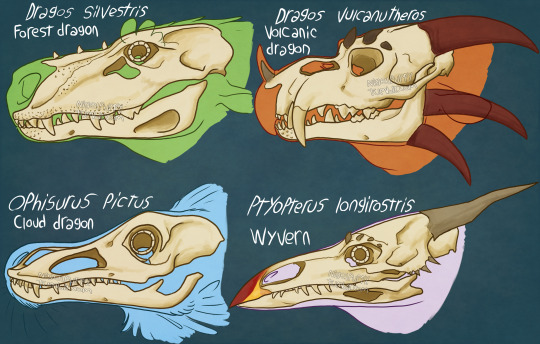
the skulls of Veynekian dragons
#my art#my characters#the tales from veynekan#speculative biology#dragon#wyvern#skull#digital art#vulture culture#nigelpuppy#2023 art#gallery tag
388 notes
·
View notes